No matter how much some individuals might like things to stay the same, the world keeps on changing. Some of those changes are small and start with one individual who wants to make personal changes while others are more sweeping, heralding an adjustment in how we move from place to place or how society treats groups of people. The wheels of change often move quickly, as when the nation was united through railroad tracks that crisscross its heartland.
Although it may be a platitude, change is, indeed, inevitable, and this week’s reviews from members of the Children’s Literature and Reading Special Interest Group examine change from several perspectives. ReadWriteThink provides a reminder that change can even relate to writing and revising. The website offers lesson ideas like “How to Revise and Edit” and “Collaborative Stories” that teachers may find helpful. “Prompting Revision through Modeling and Written Conversations” and “Inferring How and Why Characters Change” offer additional ideas for using the concept of change in reading assignments.
GRADES K-3
Casanova, Mary. (2013). One-dog sleigh. Illus. by Ard Hoyt. New York, NY: Farrar, Straus & Giroux.
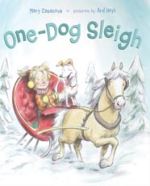 The narrator hitches up her sleigh and sets off on what she expects to be a quiet ride through the snow with her pony. But change is afoot in the form of several animals who would like to be passengers in her vehicle. One by one, several animals, including her dog, a squirrel, an owl, a lynx, and several other woodland creatures climb aboard. When the weight of all of them makes it difficult for the sleigh to move, they jump out and push it to the stop before climbing on again for a wild ride. Young readers will enjoy the rhyming text, which makes this one a perfect read-aloud title, and the colorful, action-filled illustrations that show exactly what happens when that sleigh heads down that hill with all the animals in tow. This humorous story is sure to entice just about anyone to change into outdoor clothing and head out on a sleigh ride right away.
The narrator hitches up her sleigh and sets off on what she expects to be a quiet ride through the snow with her pony. But change is afoot in the form of several animals who would like to be passengers in her vehicle. One by one, several animals, including her dog, a squirrel, an owl, a lynx, and several other woodland creatures climb aboard. When the weight of all of them makes it difficult for the sleigh to move, they jump out and push it to the stop before climbing on again for a wild ride. Young readers will enjoy the rhyming text, which makes this one a perfect read-aloud title, and the colorful, action-filled illustrations that show exactly what happens when that sleigh heads down that hill with all the animals in tow. This humorous story is sure to entice just about anyone to change into outdoor clothing and head out on a sleigh ride right away.
— Barbara A. Ward, Washington State University Pullman
Cooper, Elisha. (2013). Train. New York, NY: Scholastic, Inc./Orchard Books.
 Beautiful language coupled with stunning pictures make this book about trains an invitation to climb aboard and head off on a journey. Cooper has presented a look at many different kinds of trains and travel. First, he starts with the red-striped commuter train that leaves the city as it passes little towns as the train whizzes by. Then, he offers a look at passenger trains, and from Grand Central Station, a freight train leaves, filled with all kinds of cargo traveling to distant places. An overnight train chugs its way across the country and over the Rocky Mountains. Finally, a bullet-shaped high-speed train takes its passengers on to the big cities of the west coast.
Beautiful language coupled with stunning pictures make this book about trains an invitation to climb aboard and head off on a journey. Cooper has presented a look at many different kinds of trains and travel. First, he starts with the red-striped commuter train that leaves the city as it passes little towns as the train whizzes by. Then, he offers a look at passenger trains, and from Grand Central Station, a freight train leaves, filled with all kinds of cargo traveling to distant places. An overnight train chugs its way across the country and over the Rocky Mountains. Finally, a bullet-shaped high-speed train takes its passengers on to the big cities of the west coast.
Cooper repeats the phrase, “passengers on, passengers off” throughout the various legs of the journey and provides beautiful vistas and interior views of the different types of trains. Each ride or train brings new experiences for young readers. Teachers may want to read more about the creation of this book with an interview at the blog, Seven Impossible Things Before Breakfast.
— Karen Hildebrand, Ohio Library and Reading Consultant
Frasier, Debra. (2013). Spike: Ugliest dog in the universe. New York, NY: Simon & Schuster/Beach Lane Books.
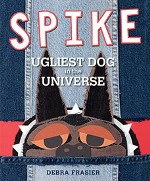 Change may come through a simple act of kindness and the addition of an animal to the household. In the case of this story, no dog could be more deserving of a loving family. After Spike wins the Ugliest Dog in the Universe contest, his owner abandons him. But Joe, the kind-hearted boy next door, is able to see beneath Spike's unattractive surface into his heart, and he begs his mother to let Spike join their family. Trying to impress her, Spike follows the advice from Evangeline, a fancy cat who lives nearby. He is as quiet and as obedient as it is possible for a canine to be. But it will take Spike's heroic efforts to thwart a cat theft to convince Joe’s mother that Spike needs a home of his own — theirs.
Change may come through a simple act of kindness and the addition of an animal to the household. In the case of this story, no dog could be more deserving of a loving family. After Spike wins the Ugliest Dog in the Universe contest, his owner abandons him. But Joe, the kind-hearted boy next door, is able to see beneath Spike's unattractive surface into his heart, and he begs his mother to let Spike join their family. Trying to impress her, Spike follows the advice from Evangeline, a fancy cat who lives nearby. He is as quiet and as obedient as it is possible for a canine to be. But it will take Spike's heroic efforts to thwart a cat theft to convince Joe’s mother that Spike needs a home of his own — theirs.
Spike really takes a bite out of crime in his neighborhood. This touching story focuses on the all-too-real problem of humans casually leaving their pets behind when it suits them. Not only does the story tug at the heartstrings, but the illustrations, created with Cansons papers, used clothing, and worn parts of 129 pairs of blue jeans, are fascinating.
— Barbara A. Ward, Washington State University Pullman
Garland, Michael. (2013). Car goes far. New York, NY: Holiday House.
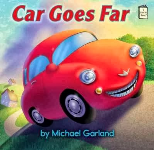 Designed for early readers, this book features opening papers with an aerial view of Car sitting in the driveway, ready for an adventure. As the picture swoops down to the driveway, Car’s headlights are seen as eyes and the front grille is a smile.
Designed for early readers, this book features opening papers with an aerial view of Car sitting in the driveway, ready for an adventure. As the picture swoops down to the driveway, Car’s headlights are seen as eyes and the front grille is a smile.
Ready to go! As the drive begins, though, everyday happenings occur along the way, starting when a truck splashes mud all over Car, and then an egg truck coughs gray smoke into a moving cloud. Finally, pigeons fly by and do what pigeons often do when overhead. Car is ready for a good wash, and quickly heads
off to the soap and suds for a good cleaning. This delightful car ride told in simple language is a treat for emerging readers. Teachers will enjoy printing the flashcards from the publisher’s website that go with this book.
— Karen Hildebrand, Ohio Library and Reading Consultant
Hillenbrand, Will. (2013). Off we go: A Bear and Mole story. New York, NY: Holiday House.
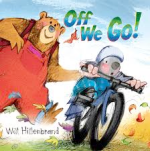 This is Hillenbrand’s third adventure with good friends, Bear and Mole. This time patient Bear is teaching Mole to ride a bike, and they begin by taking off the training wheels. Fastening on his safety helmet, Mole is ready for takeoff. Bear pats his friend on the back for good luck, and Mole begins his wobbly first attempt that ends in a crash landing with leaves flying and little critters fleeing. Mole is crying and discouraged, but Bear is there to help him try again.
This is Hillenbrand’s third adventure with good friends, Bear and Mole. This time patient Bear is teaching Mole to ride a bike, and they begin by taking off the training wheels. Fastening on his safety helmet, Mole is ready for takeoff. Bear pats his friend on the back for good luck, and Mole begins his wobbly first attempt that ends in a crash landing with leaves flying and little critters fleeing. Mole is crying and discouraged, but Bear is there to help him try again.
The second attempt is a success, and Mole gains speed and confidence as he zooms away, just in time for the Storymobile. This promises to be a great read aloud, and Hillenbrand has painted wonderful expressions on the faces of characters and used language that will keep young listeners engaged and laughing, bringing to mind their first, or yet to be, attempts at riding a bike alone. Will Hillenbrand has created a 6-minute video on the work behind this book that includes a short video of his son learning to ride a bike. Young readers will get a look at the behind-the-scenes work of an author/illustrator.
— Karen Hildebrand, Ohio Library and Reading Consultant
Judge, Lita. (2013). How big were dinosaurs? New York, NY: Macmillan/Roaring Brook Press.
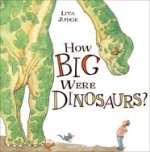 Dinosaurs roam the pages of this picture book, which puts the lie to the notion that all dinosaurs were enormous in size and lived in similar habitats. What many readers think they know about dinosaurs dies hard, but Judge provides compelling evidence that much of what has been assumed to be the case is not actually so. Because the author/illustrator juxtaposes different types of dinosaurs against animals with which most readers will be familiar, it's easy to see that dinosaurs varied in size. For instance, the Microraptor was slightly smaller than a chicken, and the Leaellynasaura was only two feet tall and lived near the South Pole.
Dinosaurs roam the pages of this picture book, which puts the lie to the notion that all dinosaurs were enormous in size and lived in similar habitats. What many readers think they know about dinosaurs dies hard, but Judge provides compelling evidence that much of what has been assumed to be the case is not actually so. Because the author/illustrator juxtaposes different types of dinosaurs against animals with which most readers will be familiar, it's easy to see that dinosaurs varied in size. For instance, the Microraptor was slightly smaller than a chicken, and the Leaellynasaura was only two feet tall and lived near the South Pole.
The book also makes it clear that size didn't necessarily translate into brain capacity or smarts; for instance, the Stegosaurus, which weighed about as much as three cows, had a walnut-size brain. The facts and comparisons come fast and furious in this picture book, which concludes with information about how scientists use fossils to help them make conjectures about the appearance of dinosaurs. The softly-colored illustrations enable readers to compare the different animals while looking at them carefully. At the end of the book, four pages fold out to reveal all the dinosaurs and modern animals featured in the book and allow young readers to size them up. This is another exceptional title from Lita Judge, who answers the title question, "How Big Were Dinosaurs?" by saying, "Not as big as you thought they were."
— Barbara A. Ward, Washington State University Pullman
Macdonald, Ross. (2013). Henry’s hand. New York, NY: Harry N. Abrams.
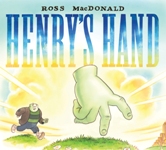 As this hilariously quirky cautionary tale proves, it is never a good idea to take your friends for granted, since you will surely miss them when they’re gone. Henry, a giant, often loses body parts. It just so happens that his right hand is his best friend. They do everything together, but after Hand begins to feel used, he leaves Henry behind. Things aren’t easy for Hand at first, and he struggles to survive on the street. But fortune smiles on Hand when he happens to be at the right place at the right time once he arrives in the city. After saving the life of a wealthy businessman, he ends up living a life of luxury amid a great deal of acclaim. He even has employees who answer his fan mail. When he receives Henry's letter of apology, Hand decides to go home since he misses his friend so much. A terrific reminder about friendship, the book is filled with lovely watercolor and pencil crayon illustrations that pay tribute to a most unusual friendship and a bond that seems likely to last.
As this hilariously quirky cautionary tale proves, it is never a good idea to take your friends for granted, since you will surely miss them when they’re gone. Henry, a giant, often loses body parts. It just so happens that his right hand is his best friend. They do everything together, but after Hand begins to feel used, he leaves Henry behind. Things aren’t easy for Hand at first, and he struggles to survive on the street. But fortune smiles on Hand when he happens to be at the right place at the right time once he arrives in the city. After saving the life of a wealthy businessman, he ends up living a life of luxury amid a great deal of acclaim. He even has employees who answer his fan mail. When he receives Henry's letter of apology, Hand decides to go home since he misses his friend so much. A terrific reminder about friendship, the book is filled with lovely watercolor and pencil crayon illustrations that pay tribute to a most unusual friendship and a bond that seems likely to last.
— Barbara A. Ward, Washington State University Pullman
Rinker, Sherri Duskey. (2013). Steam train, dream train. Illus. by Tom Lichtenheld. San Francisco, CA: Chronicle Books.
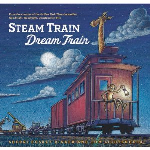 Using dark jewel tones to represent the night, the steam train, “Through the darkness, clickety-clack… /coming closer, down the track … /hold your breath so you can hear /huffing, chuffing drawing near” (unpaged) arrives at the station. All the workers are there to greet the train and begin their work. Told in clever rhyming text, the story shows how each animal is well matched for its task. Monkeys juggle many items in addition to loading the monkey bars, rabbits bounce into the open door with their pogo sticks, the giraffe works the front loader with its tall neck, while the kangaroos bounce balls into the next awaiting train car.
Using dark jewel tones to represent the night, the steam train, “Through the darkness, clickety-clack… /coming closer, down the track … /hold your breath so you can hear /huffing, chuffing drawing near” (unpaged) arrives at the station. All the workers are there to greet the train and begin their work. Told in clever rhyming text, the story shows how each animal is well matched for its task. Monkeys juggle many items in addition to loading the monkey bars, rabbits bounce into the open door with their pogo sticks, the giraffe works the front loader with its tall neck, while the kangaroos bounce balls into the next awaiting train car.
Filled with action words and action pictures, the night train is loaded. When the job is done, the crew put themselves to bed on the flatcars, and the train moves through the night. The precious last picture perfectly ends the dream train journey as readers see a small boy asleep in bed with his train set on the floor beside him. Readers may enjoy a wordless book trailer produced by the publisher. Watch for new downloadable activities at the author’s website.
— Karen Hildebrand, Ohio Library and Reading Consultant
GRADES 4-6
Floca, Brian. (2013). Locomotive. New York, NY: Simon & Schuster/Atheneum Book for Young Readers.
 From end paper, title page, to page one, and on to the last end paper, this beautifully designed book is a train-lover’s delight from start to finish. The front endpapers tell the story of the building of the Transcontinental Railroad so that the story within the pages shares the journey of an unnamed family traveling in 1869 all the way from Omaha, Nebraska to San Francisco, California. Told in poetic prose, the book immerses readers in the trip with sounds, colors, and images of train travel in those early days. The use of a wide variety, size, and style of fonts adds to the kinetic feel of the journey.
From end paper, title page, to page one, and on to the last end paper, this beautifully designed book is a train-lover’s delight from start to finish. The front endpapers tell the story of the building of the Transcontinental Railroad so that the story within the pages shares the journey of an unnamed family traveling in 1869 all the way from Omaha, Nebraska to San Francisco, California. Told in poetic prose, the book immerses readers in the trip with sounds, colors, and images of train travel in those early days. The use of a wide variety, size, and style of fonts adds to the kinetic feel of the journey.
Floca takes reader/passengers from the engine to the caboose. The jobs of the conductor, the engineer, the coal man, and the newspaper boy are visible. Readers will travel with the passengers as they get on and off at different towns, stop for a bite of food, explore parts of the train and watch the towns of America fly by. Detailed notes on the history of the locomotive add further historical background to this visual narrative of early trains. Teachers can use 3 short videos of the author talking about the book. They can also read an interesting interview from Publisher’s Weekly with authors Brian Floca and Elisha Cooper as they discuss their new books, both entitled, Train. A detailed CCSS guide can be found at Brian Floca’s website.
— Karen Hildebrand, Ohio Library and Reading Consultant
Mulder, Michelle. (2013). Pedal it!: How bicycles are changing the world. Olympia, WA: Orca Book Publishers.
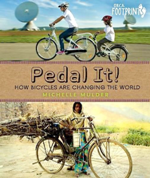 The international focus, the wonderful photographs, the informative sidebars, and the author’s enthusiasm for bicycles all make this a fascinating look at bikes, from boneshakers and high-wheels, to sprockets and gears, to all the things a bicycle can do that most people never imagined. Starting with the history of bicycles and their construction, maintenance, and use, the author discusses the evolution of the bicycle through today’s aerodynamic designs. Learning to ride a bike is also explained.
The international focus, the wonderful photographs, the informative sidebars, and the author’s enthusiasm for bicycles all make this a fascinating look at bikes, from boneshakers and high-wheels, to sprockets and gears, to all the things a bicycle can do that most people never imagined. Starting with the history of bicycles and their construction, maintenance, and use, the author discusses the evolution of the bicycle through today’s aerodynamic designs. Learning to ride a bike is also explained.
The author shares vignettes of stories and her many, many bicycle sightings around the world. Actually, she explains not just sightings, but how important bicycles are in meeting a large number of countries’ economics and transportation needs. In addition to the health benefits of pedaling, the author describes how bicycles are helpful as ambulances, or taxis, or basket-filled couriers of all kinds of food and trade goods. For bike-lovers young and old, the book will appeal to a wide audience who will enjoy this colorful and informative history and explanation of the wonders of bicycling. ReadWriteThink offers a lesson idea entitled: “Our Classroom: Writing an Owner’s Manual.” Visit the author’s website and learn about her Skype visits to classrooms. The publisher’s website offers CCSS connections for this book.
— Karen Hildebrand, Ohio Library and Reading Consultant
GRADES 7-8
Anderson, T. Neill. (2013). City of the dead: Galveston hurricane, 1900. Watertown, MA: Charlesbridge Publishers.
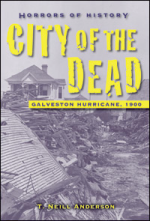 As today’s news is full of the recent devastation in the Philippines, another disaster in American history is remembered. Considered the deadliest storm in U.S. history, the 1900 hurricane that slammed onto the Texas coastline in the Gulf of Mexico changed the landscape of Galveston forever. The island city of Galveston was one of the biggest ports in the United States a hundred years ago. Over 6,000 people were killed, and some estimates report 8,000 deaths on that day on September 8, 1900. The water rose so suddenly that many people were trapped in collapsing buildings while high winds thought to be around 120 miles an hour whisked debris and bodies everywhere.
As today’s news is full of the recent devastation in the Philippines, another disaster in American history is remembered. Considered the deadliest storm in U.S. history, the 1900 hurricane that slammed onto the Texas coastline in the Gulf of Mexico changed the landscape of Galveston forever. The island city of Galveston was one of the biggest ports in the United States a hundred years ago. Over 6,000 people were killed, and some estimates report 8,000 deaths on that day on September 8, 1900. The water rose so suddenly that many people were trapped in collapsing buildings while high winds thought to be around 120 miles an hour whisked debris and bodies everywhere.
Author T. Neill Anderson has created an amazing book of historical fiction based on actual accounts using oral histories, letters, interviews and records from Sisters of Charity of the Incarnate Word as he recounts what it must have been like that horrible day. Black and white photographs add to the disastrous fact-based storyline. This fast-paced narrative depicting several points of view will appeal to middle and high school readers.
— Karen Hildebrand, Ohio Library and Reading Consultant
Gantos, Jack. (2013). From Norvelt to nowhere. New York, NY: Farrar, Straus & Giroux.
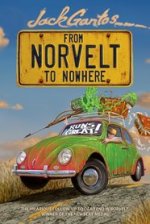 As twelve-year-old Jack Gantos and his parents prepare to leave the town of Norvelt, Pennsylvania behind for a move to Florida, the town's serial killer strikes again. This time, he (or she) poisons Mrs. Custard on Halloween. Jack has the bright idea of dressing up like Spizz, the presumed murderer of all those elderly women in the previous title, Dead End in Norvelt (Farrar, Straus & Giroux, 2011). Needless to say, his costume does not go over well. When Eleanor Roosevelt, the town's founder, dies, Miss Volker needs Jack's assistance and makes a pilgrimage to her heroine’s grave site. Their journey, by train and car, takes them through Miss Volker's hometown of Rugby, Tennessee, on their way to Florida where she plans to catch the villain responsible for all those Norvelt deaths.
As twelve-year-old Jack Gantos and his parents prepare to leave the town of Norvelt, Pennsylvania behind for a move to Florida, the town's serial killer strikes again. This time, he (or she) poisons Mrs. Custard on Halloween. Jack has the bright idea of dressing up like Spizz, the presumed murderer of all those elderly women in the previous title, Dead End in Norvelt (Farrar, Straus & Giroux, 2011). Needless to say, his costume does not go over well. When Eleanor Roosevelt, the town's founder, dies, Miss Volker needs Jack's assistance and makes a pilgrimage to her heroine’s grave site. Their journey, by train and car, takes them through Miss Volker's hometown of Rugby, Tennessee, on their way to Florida where she plans to catch the villain responsible for all those Norvelt deaths.
Readers may especially enjoy the bits of history sprinkled throughout the book as Miss Norvelt writes Eleanor's obituary, but the increasingly eccentric and abusive behavior of Miss Volker herself may wear thin quickly. Still, laughing most of the way, readers will willingly follow Jack and Miss Volker to the end of the line and the changes that await them there. The book is an excellent reminder of the complexity of human beings, whether they are actual historical figures such as presidents or fictional ones such as Miss Volker.
— Barbara A. Ward, Washington State University Pullman
Kinney, Jeff. (2013). Diary of a wimpy kid: Hard luck. New York, NY: Abrams/Amulet Books.
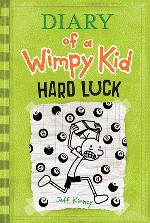 With the Diary of a Wimpy Kid craze showing no signs of dissipating, the latest title offers fans another slice of Greg Heffley’s life. Things aren't going very well for Greg; in fact, his life might be summed up as the lines in a country song: "If it weren't for bad luck, I'd have no luck at all." Clearly, something needs to change. He and best friend Rowley barely have time for each other since Rowley spends all his time with his new girlfriend Abigail, and Greg can't seem to find anyone else to hang out with at school. He considers joining clubs and befriending someone else and even gets involved in the yearbook, but still, he can’t find a good friend or change his luck.
With the Diary of a Wimpy Kid craze showing no signs of dissipating, the latest title offers fans another slice of Greg Heffley’s life. Things aren't going very well for Greg; in fact, his life might be summed up as the lines in a country song: "If it weren't for bad luck, I'd have no luck at all." Clearly, something needs to change. He and best friend Rowley barely have time for each other since Rowley spends all his time with his new girlfriend Abigail, and Greg can't seem to find anyone else to hang out with at school. He considers joining clubs and befriending someone else and even gets involved in the yearbook, but still, he can’t find a good friend or change his luck.
Various amusing vignettes about Greg’s family, including his aunts and cousins, are threaded into the narrative. When Greg finds a Magic 8 Ball, he decides to let it determine his future actions. Of course, with its vague responses, this leads to many problems. Although the book is hilarious at many points, it also has a serious side as Greg happens upon evidence that changes how he regarded his childhood. Those who are sure that this author/illustrator has run out of things to say might as well prepare for more ruminations from the Wimpy Kid since Jeff Kinney continues to rely on Greg's family history for rich material. Here’s hoping the popular series never ends.
— Barbara A. Ward, Washington State University Pullman
Thimmesh, Catherine. (2013). Scaly spotted feathered frilled: How do we know what dinosaurs really looked like? Boston, MA: Houghton Mifflin Harcourt Books for Young Readers.
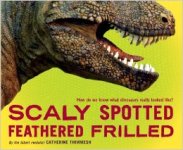 Readers will be mesmerized by this informative text that’s likely to change what you know about dinosaurs and how they are studied. Anyone interested in the ancient creatures will be fascinated by this title. Accompanied by colorful illustrations from paleoartists who rely on fossils and accompanying evidence to flesh out what dinosaurs might have looked like, the text describes how today's scientists and artists have revised early ideas about the likely appearances of dinosaurs. While much of their work is still only conjecture, it is closer to what the truth might have been than the first renditions of dinosaurs. Most intriguingly, the author recounts how some of the artists eventually decided to incorporate feathers in many of the dinosaurs they replicated as they began to recognize the connection between birds and dinosaurs. This is mesmerizing and opinion-altering stuff, especially since there is no way to know just how accurate any of the artists’ depictions are.
Readers will be mesmerized by this informative text that’s likely to change what you know about dinosaurs and how they are studied. Anyone interested in the ancient creatures will be fascinated by this title. Accompanied by colorful illustrations from paleoartists who rely on fossils and accompanying evidence to flesh out what dinosaurs might have looked like, the text describes how today's scientists and artists have revised early ideas about the likely appearances of dinosaurs. While much of their work is still only conjecture, it is closer to what the truth might have been than the first renditions of dinosaurs. Most intriguingly, the author recounts how some of the artists eventually decided to incorporate feathers in many of the dinosaurs they replicated as they began to recognize the connection between birds and dinosaurs. This is mesmerizing and opinion-altering stuff, especially since there is no way to know just how accurate any of the artists’ depictions are.
— Barbara A. Ward, Washington State University Pullman
Westrick, Anne. (2013). Brotherhood. New York: Viking/Penguin Group.
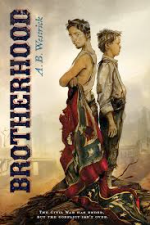 Things changed after the Civil War, especially in the south. The setting is 1867 in Richmond, Virginia. Reconstruction is underway, carpetbaggers have moved in and Yankee soldiers are stationed to restore peace and oversee the rebuilding of the city. Shadrach has lost his father to the war, as did many other children and families in the south. His older brother Jeremiah is still fighting the war, and his hatred of the Yankees steers him into joining a new organization that pledges to help Confederate war widows. They take the name of Ku Klux Klan. Shad follows his brother one night and unwittingly becomes part of the Klan. However, Shad has not only become friends with a young educated Negro girl, but she has also offered to teach him to read if he will teach her colored students the trade of sewing like Shad’s family’s tailoring business.
Things changed after the Civil War, especially in the south. The setting is 1867 in Richmond, Virginia. Reconstruction is underway, carpetbaggers have moved in and Yankee soldiers are stationed to restore peace and oversee the rebuilding of the city. Shadrach has lost his father to the war, as did many other children and families in the south. His older brother Jeremiah is still fighting the war, and his hatred of the Yankees steers him into joining a new organization that pledges to help Confederate war widows. They take the name of Ku Klux Klan. Shad follows his brother one night and unwittingly becomes part of the Klan. However, Shad has not only become friends with a young educated Negro girl, but she has also offered to teach him to read if he will teach her colored students the trade of sewing like Shad’s family’s tailoring business.
Readers will recognize that Shad is dyslexic and has never been able to learn to read, and he is desperate to do so. The bargain he makes with Rachel is costly. As Klan activities swell to deadly heights, the inner turmoil in Shad and the changing landscape of the South and the newly freed slaves make for a clash in the minds of many people as Shad tries to sort out right from wrong. The author provides a detailed discussion guide at her website. Teachers might like to use the ReadWriteThink lesson plan idea, “Using Historical Fiction to Learn About the Civil War.” Pair this book with Susan Campbell Bartoletti’s They Called Themselves the KKK: The Birth of an American Terrorist Group (Houghton Mifflin Harcourt, 2010).
— Karen Hildebrand, Ohio Library and Reading Consultant
GRADES 9-12
Clark, Kristin Elizabeth. (2013). Freakboy. New York, NY: Farrar, Straus & Giroux.
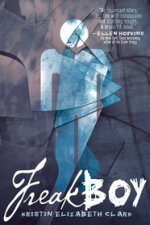 This important book, a novel in verse, covers territory that has rarely been explored in literature for teens—gender variance. Told from three points of view, those of Brendan Chase, a wrestler and top student who realizes that he may be transsexual; Vanessa, his girlfriend who has forsaken all her other friends for him; and Angel, who volunteers at a center for LGBTQ teens, the book explores the life experiences and emotions of all three main characters as their lives intersect. All three main characters are likeable, and readers will hope for a happy ending to the story while also knowing that having such a happy ending isn't likely. The author makes it clear just how hard it is for Brendan to accept himself and his burgeoning desire to feel like a woman, and even if he does, how difficult it may be to gain the acceptance and understanding of others.
This important book, a novel in verse, covers territory that has rarely been explored in literature for teens—gender variance. Told from three points of view, those of Brendan Chase, a wrestler and top student who realizes that he may be transsexual; Vanessa, his girlfriend who has forsaken all her other friends for him; and Angel, who volunteers at a center for LGBTQ teens, the book explores the life experiences and emotions of all three main characters as their lives intersect. All three main characters are likeable, and readers will hope for a happy ending to the story while also knowing that having such a happy ending isn't likely. The author makes it clear just how hard it is for Brendan to accept himself and his burgeoning desire to feel like a woman, and even if he does, how difficult it may be to gain the acceptance and understanding of others.
Those who like to put individuals into tidy little boxes will find this book disconcerting as its characters defy easy classification. Brendan, for instance, enjoys sex with Vanessa while also fantasizing about having soft skin and long, feminine hair and wearing female undergarments. When his best friend bursts into Brendan’s room while he is wearing the bra he purchased at Victoria’s Secret, Brendan knows that his life will be changed forever. Reading the book may open the minds of those who would judge Brendan harshly, while reminding many readers that gender is not dependent on the sex organs with which individuals are born. This one should generate a lot of discussion—and maybe encourage changes in attitudes toward those like Brendan.
— Barbara A. Ward, Washington State University Pullman
These reviews are submitted by members of the International Reading Association's Children's Literature and Reading Special Interest Group (CL/R SIG) and are published weekly on Reading Today Online. The International Reading Association partners with the National Council of Teachers of English and Verizon Thinkfinity to produce ReadWriteThink.org, a website devoted to providing literacy instruction and interactive resources for grades K–12.